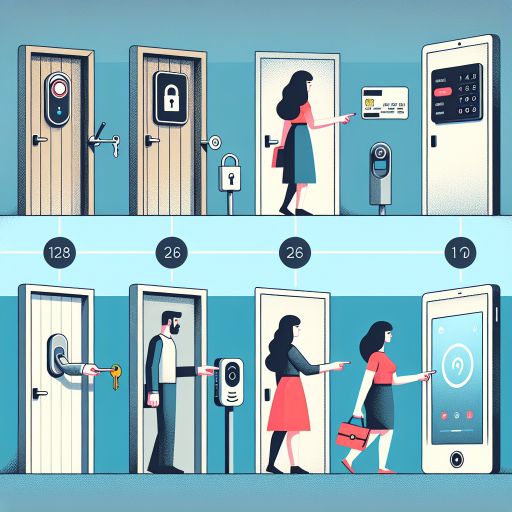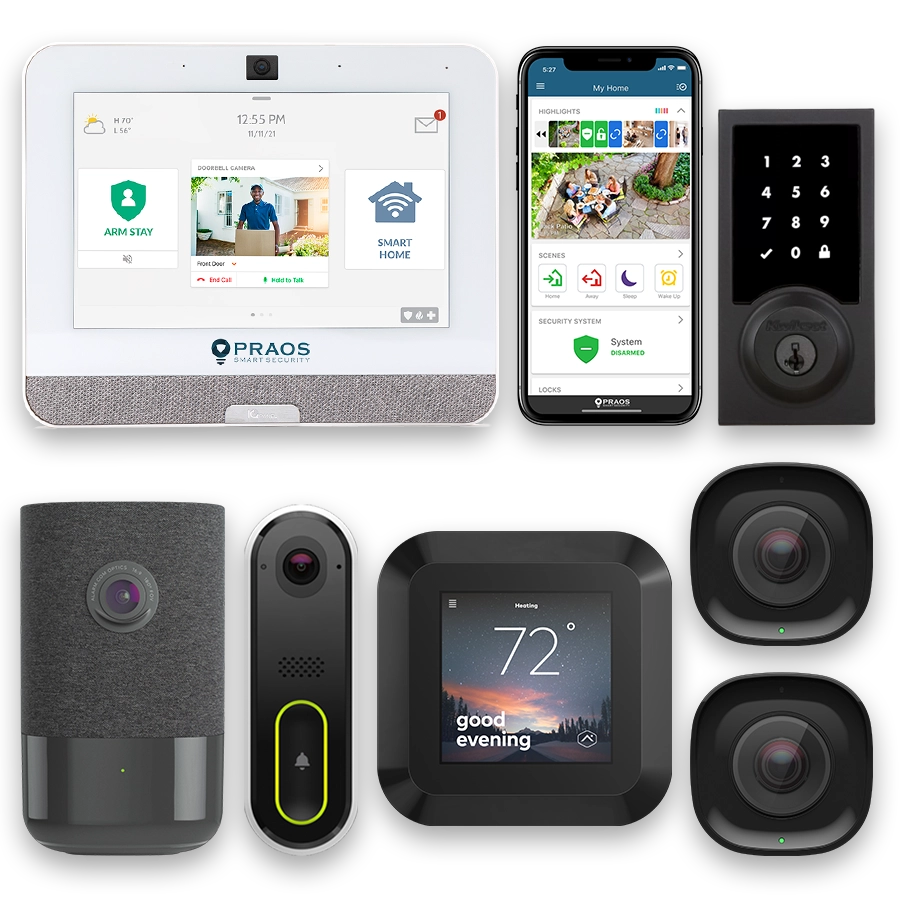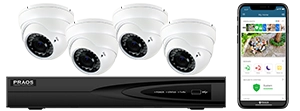The Evolution of Home Security Systems

Security Cameras
Home security systems have undergone significant transformations over the decades. Initially, the concept of home security was limited to basic mechanical locks and simple alarm systems. These early systems provided a rudimentary form of protection but lacked advanced capabilities and integration that modern technology offers.
In the mid-20th century, home security began to evolve with the introduction of more sophisticated alarm systems. These systems typically included burglar alarms that could detect unauthorized entry through doors and windows. The advent of wired alarm systems marked a significant leap as they allowed for a more robust and reliable means of securing homes. However, these systems were often expensive and complex to install, making them less accessible to the average homeowner.
The 1990s and early 2000s saw the proliferation of digital technology, which began to influence home security systems. This era brought about the integration of motion detectors, security cameras, and centralized monitoring services. Digital technology made these systems more effective and user-friendly, enabling homeowners to have a greater sense of control over their security. However, the systems still primarily relied on manual monitoring and basic alerts.
In recent years, the landscape of home security has been revolutionized by advancements in artificial intelligence (AI) and smart technology. Modern home security systems now incorporate AI to enhance detection capabilities, automate responses, and provide predictive analytics. These systems can learn from patterns and behaviors, making them more effective in identifying genuine threats while reducing false alarms.
Smart technology and the Internet of Things (IoT) have also played a crucial role in this evolution. Smart devices such as cameras, doorbells, and locks can be interconnected and controlled remotely via smartphones or other smart devices. This interconnectedness allows for more comprehensive surveillance and control, offering homeowners real-time insights and actions from anywhere in the world.
Overall, the evolution of home security systems reflects a shift from basic mechanical solutions to highly intelligent, interconnected systems. This progression highlights the growing importance of technology in enhancing home safety and the ongoing efforts to provide more sophisticated, reliable, and user-friendly security solutions.
Artificial Intelligence in Modern Home Security
Artificial Intelligence (AI) has made significant strides in reshaping various sectors, and home security is no exception. The integration of AI in home security systems offers an array of advanced features designed to enhance safety and efficiency.
One of the key applications of AI in modern home security is intelligent video analysis. Traditional surveillance cameras merely record footage, but AI-powered cameras can analyze video feeds in real-time to identify unusual activities. This capability can distinguish between normal movements, such as a pet wandering around, and potential security threats, such as an intruder attempting to break in. By reducing false alarms, AI technology ensures that homeowners and security personnel are alerted only when necessary.
Another significant contribution of AI to home security is facial recognition technology. This technology allows systems to differentiate between family members, friends, and unknown individuals. When integrated with smart locks, facial recognition can automatically grant or deny access to the home. For example, a smart doorbell equipped with AI can notify homeowners when a non-recognized individual approaches, providing an added layer of security.
Voice recognition is another area where AI enhances home security. AI-powered voice assistants, like Amazon Alexa or Google Assistant, can be integrated with alarm systems to allow voice-activated control. Users can arm or disarm their systems, check the status of security devices, and even receive alerts via voice commands. This hands-free interaction with security systems simplifies user experience while maintaining robust security measures.
Moreover, AI has the capability to learn and adapt over time, making home security systems more effective. Machine learning algorithms can analyze data from various sensors and cameras to identify patterns and predict potential threats. For instance, AI can recognize the typical comings and goings of household members and flag any deviations from these patterns as potential security concerns. This predictive analysis can provide early warnings and allow for proactive security measures to be taken.
Integrating AI with other smart technologies, such as Internet of Things (IoT) devices, further amplifies its benefits. AI can effectively coordinate multiple devices, such as cameras, motion detectors, and smart locks, creating a cohesive security ecosystem. For example, if a motion sensor detects movement during unusual hours, it can trigger the camera to start recording and notify the homeowner immediately.
Current advancements in natural language processing (NLP) enable AI systems to understand and respond to user queries more effectively. Homeowners can interact with their security systems using conversational language, making it easier to manage and customize security settings based on their preferences.
AI’s data analysis capabilities are also invaluable in identifying and addressing vulnerabilities in home security systems. By continuously monitoring and analyzing system performance, AI can detect anomalies, propose enhancements, and even predict potential system failures before they occur. This proactive maintenance ensures that security systems remain reliable and up-to-date.
As AI technology continues to evolve, its role in home security is expected to expand, offering more sophisticated and user-friendly solutions to keep homes safe. The integration of AI in modern home security systems represents a significant leap forward in the quest for safer, smarter homes.
Role of Smart Technology and IoT in Alarm Systems

Security Cameras
Smart technology and the Internet of Things (IoT) have significantly transformed the landscape of home security systems. These advancements enable devices to communicate with one another, creating a more comprehensive and interconnected security network within homes.
One of the primary roles of smart technology in alarm systems is increased connectivity. Homeowners can now connect various security devices—such as cameras, motion sensors, and alarm sirens—to a central hub or control panel. This interconnectedness allows for real-time updates and notifications, providing users with immediate alerts to their smartphones or other devices when security breaches occur.
An essential aspect of IoT in alarm systems is remote access and control. Homeowners can monitor and manage their security systems from anywhere in the world through mobile applications. This capability is particularly useful for arming or disarming alarm systems, viewing camera feeds, or receiving and responding to alerts promptly.
Moreover, smart technology contributes to automation within home security. For example, lighting systems can be programmed to turn on and off at specific times or in response to detected movement. Such automation can deter potential intruders by simulating the presence of occupants in the house. Additionally, integrating smart locks with alarm systems allows for more secure access control, enabling homeowners to lock and unlock doors remotely or provide temporary access codes to guests.
The role of smart technology also extends to enhanced data analytics. Devices connected through IoT can collect and analyze data to identify unusual patterns or behaviors. Such insights can improve the accuracy of threat detection and reduce false alarms, making security systems more reliable and efficient.
Lastly, the interoperability of smart technology ensures that different security devices can work together seamlessly. Compatibility with various platforms and devices allows homeowners to create a customized security ecosystem tailored to their specific needs.
In summary, smart technology and IoT play a crucial role in modern alarm systems by improving connectivity, remote access, automation, data analytics, and interoperability. These enhancements collectively provide a more robust and effective home security solution, offering greater peace of mind for homeowners.
Benefits and Challenges of Integrating AI in Home Security
Integrating AI in home security has brought about numerous benefits as well as certain challenges that need to be addressed. Understanding these aspects is essential for consumers, developers, and policymakers alike.
Benefits:
- Enhanced Threat Detection: AI algorithms can analyze vast amounts of data from various sensors, identifying unusual patterns and potential threats more accurately than traditional systems.
- Real-Time Alerts: AI-powered systems provide instant notifications to homeowners and authorities, reducing response times and potentially preventing incidents.
- Cost Efficiency: By minimizing false alarms and optimizing resource allocation, AI contributes to more efficient monitoring and lowers operational costs.
- Automation and Smart Integration: AI seamlessly integrates with other smart home devices, offering automated responses like locking doors, turning on lights, or adjusting cameras based on detected activities.
- Learning and Adaptation: Over time, AI systems learn the behavior patterns of household members, minimizing disruptions and increasing accuracy in distinguishing between routine activities and genuine threats.
Challenges:
- Privacy Concerns: AI systems often require vast amounts of data to function effectively, raising concerns about data privacy and user consent. Ensuring that data collection and usage comply with stringent privacy regulations is essential.
- Cybersecurity Risks: As with any connected technology, AI-based security systems are susceptible to hacking and cyber-attacks. Continuous advancements in cybersecurity measures are necessary to protect these systems from breaches.
- Technical Reliability: The effectiveness of AI in home security can be compromised by technical glitches, software bugs, or hardware failures. Regular maintenance and updates are crucial to ensure reliability.
- Cost of Implementation: Initial setup costs for AI-integrated home security systems can be high, potentially limiting accessibility for some users. However, long-term savings and advancements may offset this challenge over time.
- Regulatory and Ethical Considerations: The deployment of AI in home security must navigate various regulatory landscapes and address ethical concerns, such as bias in AI algorithms and fair implementation practices.
In summary, while the integration of AI in home security systems offers significant advantages in terms of accuracy, efficiency, and convenience, it also presents challenges that must be systematically managed. Balancing these benefits and challenges will be crucial for the continued advancement and adoption of AI-driven home security solutions.
Current Trends and Innovations in AI-Driven Security
In recent years, significant advancements in technology have led to transformative changes in home security systems. Platforms driven by artificial intelligence (AI) and smart technology have introduced various innovative solutions that are enhancing safety measures in residential premises. Understanding the current trends and innovations is crucial for comprehending the future direction of home security.
One of the most notable trends is the incorporation of machine learning algorithms in security systems. These algorithms enable devices to improve their performance over time by learning from data. For example, security cameras equipped with AI can recognize familiar faces and differentiate between regular household activity and potential threats. This reduces the occurrence of false alarms and increases the overall reliability of the system.
Another significant innovation is the integration of smart sensors. These sensors are capable of detecting changes in the environment, such as motion, temperature, or sound. When linked with AI, these systems can analyze data to identify patterns and predict potential security breaches before they occur. This proactive approach offers enhanced protection by addressing issues preemptively rather than reactively.
Voice recognition technology is also making its mark in the home security domain. Security systems now often come equipped with voice control features, allowing users to manage their home security settings through simple voice commands. This is particularly useful in emergency situations where quick access to system controls is essential.
The use of cloud computing in home security systems is rising. Cloud-based platforms allow for real-time monitoring and data storage. This ensures that even if a local system is compromised, data referenced and stored in the cloud remains safe and accessible. Additionally, remote access features enable homeowners to monitor their property from anywhere in the world via smartphones or computers.
| Current AI-Driven Security Trends | Key Features |
|---|---|
| Machine Learning Algorithms | Self-improving, reduces false alarms |
| Smart Sensors | Environmental detection, predictive analysis |
| Voice Recognition | Voice control, emergency access |
| Cloud Computing | Real-time monitoring, remote access |
Furthermore, AI-driven security systems are increasingly incorporating advanced data analytics to provide homeowners with comprehensive security insights. These analytics help in identifying potential vulnerabilities and suggest measures to fortify security protocols.
Lastly, the trend of integrating home security systems with other smart home devices continues to grow. This integration allows for a seamless user experience where all devices work together to enhance overall home safety. For instance, linking security cameras with smart doorbells and locks can create a synchronized defense mechanism that offers multiple layers of protection.
Future Outlook and Emerging Technologies in Home Security
As we peer into the future of home security, the integration of artificial intelligence (AI) and smart technology is expected to continue evolving, bringing about advanced and more reliable systems. With the rapid advancement of technology, several emerging trends and technologies are likely to shape the future landscape of home security systems.
One prominent trend is the use of edge computing in security devices. Edge computing allows data processing to occur closer to the source where it is generated rather than relying on a centralized server. This reduces latency and improves response times, which is crucial for real-time security applications. It also enhances privacy, as sensitive data does not need to be transmitted to distant servers for analysis.
AI-driven analytics will also play a significant role in future home security systems. Sophisticated algorithms will be capable of recognizing patterns and detecting anomalies with greater accuracy. This could mean improved identification of potential threats, fewer false alarms, and more efficient use of security resources. For example, AI can analyze video feeds to distinguish between a family member and an intruder, making systems more intelligent and adaptive.
Another key development is the advent of 5G networks. The increased speed and bandwidth provided by 5G will support the deployment of more data-intensive applications and devices within smart home environments. With faster data transmission rates, security systems will be able to leverage high-definition video streaming and advanced AI processing capabilities without significant latency.
Additionally, the use of biometric authentication is expected to become more widespread. Technologies such as facial recognition, fingerprint scanning, and voice recognition provide a higher level of security compared to traditional password or PIN-based systems. These methods can help prevent unauthorized access and ensure that only authorized individuals can enter the home.
Furthermore, the future may see the integration of blockchain technology for enhanced security and data integrity. Blockchain’s decentralized nature can protect security systems from hacking attempts and data breaches. It can also enable secure, verifiable, and tamper-proof records of all security-related activities, ensuring transparency and accountability.
Lastly, the continued growth of smart home ecosystems will likely lead to more interoperable and cohesive security solutions. As different smart devices become more interconnected, a unified security system can be created that offers comprehensive protection. For instance, integrating smart locks, cameras, sensors, and alarm systems can provide a holistic approach to home security.
In conclusion, the future of home security is poised to be heavily influenced by advancements in AI, edge computing, 5G, biometric authentication, blockchain, and the expanding smart home ecosystem. These technologies will work together to create more secure, efficient, and reliable home security systems that adapt seamlessly to the needs of modern households.



